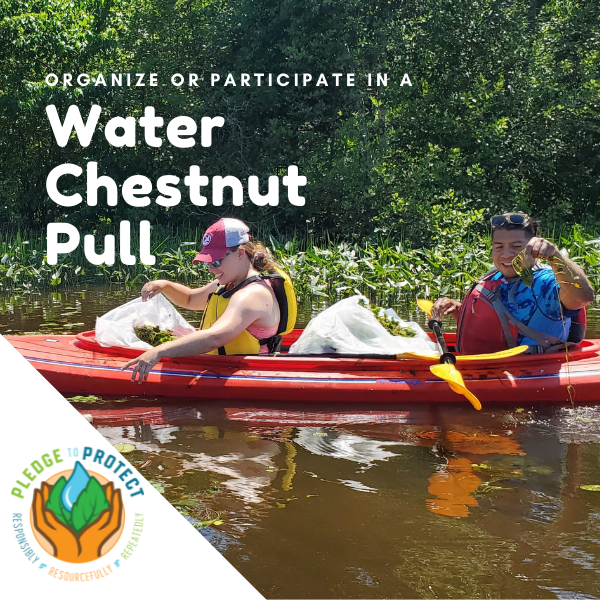A special thank you to Laura Schappert, a 2022 Watercraft Inspection Steward, for contributing to this blog.
European water chestnut is an invasive aquatic plant that was introduced to the Cambridge Botanical Garden in the mid-1800s. It has since spread throughout the northeastern United States, including New York State, and today it can be found in over 40 counties in New York.
Water chestnut thrives in the shallow sections of lakes, ponds, and slow-moving rivers and streams. It roots itself in the soil and sends up stalks that end in dense floating rosettes of triangular, toothed leaves.
Water chestnuts grow thick, dense, floating mats that impede aquatic recreation, reduce waterfront property values, and alter aquatic ecosystems. Their nutlets are so sharp that they can injure people and pets if stepped on, or even puncture tires if driven over. When the leaves die back, their decomposition removes the oxygen from the water, which negatively affects local fish populations.

Removing water chestnut plants is important for the health of local fish populations as well as for the safety of people and for the ease of waterway use. Like many aquatic plants, water chestnut can reproduce rapidly. Each nutlet can produce 10-15 new plants, and each leaf rosette can produce 15-20 nutlets that remain viable in the sediment for several years. Water chestnut can easily get caught on boats, equipment, and trailers and be unknowingly spread to new areas, so it is important for boaters to inspect their watercraft and trailer before entering a body of water and to clean, drain, and dry their watercraft after each use.
Take Action!
Organize or Participate in a Water Chestnut Pull
Water chestnut populations can be suppressed manually. If you own waterfront property where water chestnut is growing, you can take action by talking to your neighbors and organizing a water chestnut pull or you can join hand-pull efforts scheduled to occur in your area (see below for upcoming hand-pulls in the SLELO region and beyond).
Water chestnut hand-pulls are best held during the summer when their floating rosettes are present but before their fruits ripen and lower to the sediment (typically from late June through early August). Pulls can be conducted by boat using a canoe, kayak, or small motorboat, however, plants may tangle in the motor. If wading in the water to remove water chestnuts, take care to protect your feet from their sharp nutlets.
When pulling water chestnut plants, only the leaves and fruits need to be removed. Water chestnuts are an annual plant. Without leaves, the roots die, and without seeds, the plant cannot spread. Pulling the roots disrupts the sediment at the bottom of the water body. If the sediment comes loose and migrates, it can lead to changes in the shape of rivers and streams, as well as leading to a lack of nutrients for native water plants.
Removed plants can be composted on land as long as they are placed away from water and can’t be accidentally washed into nearby waterways. If you don’t have a site where you can compost the removed plants, you can bag them and bring them to a local landfill.
If you conduct a water chestnut pull, it is important to report your efforts to iMapInvasives—New York’s Invasive Species Database. Below are step-by-step instructions on how to conduct and record a pre-treatment survey and post-treatment data to iMapInvasives.

Water Chestnut Pulls Occurring in the SLELO Region
- Thursday, July 25th, 10 AM-4 PM Village of Heuvelton, Oswegatchie River Water Chestnut Removal. Register to join!
To receive announcements for upcoming water chestnut pulls in the SLELO region, please click the button below to become a SLELO volunteer and select “aid water chestnut removals” as an opportunity you’re interested in joining.
Upcoming State-wide Water Chestnut Pulls
- Dates/locations to be determined.
Each year, thousands of pounds of water chestnut (Trapa natans) are pulled by professionals and volunteers across the state. These efforts help protect our natural resources from the negative impacts of this invasive species – help us track these efforts!
Visit the iMapInvasives Water Chestnut Organizer’s Dashboard to get These Resources:
- Tips on how to organize a water chestnut pull.
- iMap tutorials for mapping water chestnut removal efforts.
- View annual reports for removal efforts as they become available.
Report Water Chestnut Removal Efforts to iMapInvasives
Download the guide or see below for step-by-step instructions.




You can use the form below to record information about the infestation during a hand pull which will be later used to record treatment data into iMapInvasives online. You can also utilize the iMapInvasives mobile app and drop observation points along the perimeter of the infestation during the pull. Be sure to add distribution type (trace, sparse, dense, monoculutre), and estimated quantities removed in the comments section.

Did you enjoy this blog post? Take our Pledge to Protect and get monthly emails showcasing actions you can take to protect your favorite hiking trails, paddleways, forests, garden, and community from the impacts of invasive species!
Take the Pledge to Protect
The Pledge-to-Protect is a fun, positive, inviting, engaging and rewarding way to participate in invasive species prevention and management.
|
|



